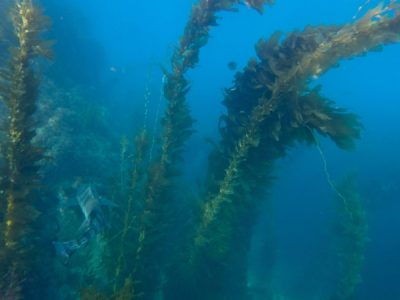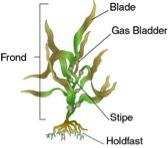
What has the world’s fastest linear growth, contains remedies for everything from heartburn to wrinkles, and might be in your t-shirt right now and in the PB&J you had for lunch?
If you said giant brown kelp, Macrocystis pyrifera, you’re right!
Tree of life
Algae is different from land plants because it lacks a root system that sucks up water and nutrients from the soil, instead using a root-like system called a holdfast, a cone-shaped network of branches called haptera, to anchor to its substrate. However, its growth is so successful because the more mature blades near the water’s surface can efficiently transfer excess sugars through passageways called sieve tubes down to the younger blades below that cannot yet provide all the energy they need through photosynthesis.
 Image from KelpWatch, found at http://www.geol.utas.edu.au/kelpwatch/facts_b.html
Image from KelpWatch, found at http://www.geol.utas.edu.au/kelpwatch/facts_b.html
Giant brown kelp is part of the phylum Ochrophyta, named for the ochre-colored pigments in its blades (or “lamina”). Instead of chlorophyll, this phylum uses a brown pigment called fucoxanthin in photosynthesis, giving it the brown color that makes it part of the class phaeophyta, the brown algae. Brown algae is the most diverse of the three classes of algae (brown, red, and green) — it comes in all shapes and sizes, and includes the world’s largest algae, like Macrocystis pyrifera!
Sequoia of the sea
Macrocystis pyrifera is the world’s largest seaweed, reaching 50-60 meters in length and 100 kg in weight, with blades up to 70 cm long. In ideal conditions (shallow rocks or coarse sand in cool, nitrogen-rich waters) it can grow 50-60 cm in a single day – that’s almost two feet – and 45 m in a single growing season – that’s as tall as the Statue of Liberty! Giant brown kelp is perennial, which means that it often dies back to its holdfast in winter, losing up to three quarters of its mass before regrowth in warmer season. Kelp can live up to five to eight years, and its massive size has given it the nickname “sequoia of the sea.”
 Image from Tours de Jours comic strip, Catalina Islander, found at MicrobeWiki.Kenyon.edu
Image from Tours de Jours comic strip, Catalina Islander, found at MicrobeWiki.Kenyon.edu
Lay it on thick
Alginate, algin, or alginic acid, is a thickener found in many household products that is derived from the cell walls of brown algae. Sodium alginate is the main gum extracted from giant brown kelp, but other forms of this gel-like substance include potassium alginate and calcium alginate.
These products are used in manufacturing paper and fabric, in dyes, for waterproofing and fireproofing, and as a thickener for drinks, ice cream, creamy or gel-like foods (such as jelly or Velveeta cheese) and cosmetics, and even as an alternative wound dressing.
Extract from giant brown kelp, which is rich and vitamins and minerals including iodine, is also taken as a dietary supplement to promote healthy hair, skin, and nails. Rich in vitamins C and E, it has anti-inflammatory and antioxidant properties. It has also been proven to enhance natural collagen and elastin, proteins in skin that keep it firm and strong, and has been proven to reverse sun damage and prevent wrinkles.
A plant in San Diego operated for 76 years and until its closure in 2005 was the largest kelp harvesting facility in the world. Today, M. pyrifera is still harvested by large barges with spinning blades underneath them that act like marine lawnmowers, for these industrial uses as well as feed in abalone aquaculture.
Floating forests
Kelp is a key organism in shallow ecosystems because it provides plentiful food and shelter for otters, urchins, and many sessile invertebrate species. Macrocystis is the most widely distributed genus of kelp in the world, forming large, dense forests from Australia and New Zealand to South Africa all the way up the western coasts of the Americas. A study off San Clemente found that just as in a terrestrial rainforest, giant brown kelp outcompetes smaller understory kelp, opening up ample space for sessile invertebrates on the bottom. Often, the top layers of a kelp canopy will break off to form a kelp raft, a floating community rich in biodiversity. This is key in both the life cycle of the kelp and of its inhabitants, allowing reproductive spores to travel 1,000 km or more to start new colonies. Some small invertebrates even complete an entire life cycle including a planktonic larval phase, adult phase, and new generation before a kelp raft sinks or floats ashore.
To learn more about giant brown kelp, check out the Seaweed Industry Association website or this page in the Encyclopedia of Life. To see some awesome photos of kelp being harvested off the California coast, check out this collection.


